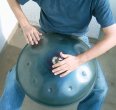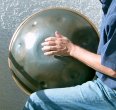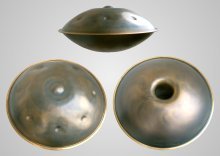Hang (musical instrument)
The hang [ haŋ ] (plural: hanghang ) is a musical instrument . It consists of two hemispherical segments made of pang , a gas nitrided sheet steel, glued together . On the upper half-shell there are sound fields that - similar to the steelpan - are worked into the sheet metal with hammers.
The slope is held horizontally or vertically on the lap. It is played with the fingers and hands, which resulted in the name: Hang is Bern German for hand .
The instrument was invented in 2000 by Felix Rohner and Sabina Schärer in Bern . From 2001 it was built exclusively by PANArt Hangbau AG in various stages of development . At the end of 2013, the construction of the slope was stopped. Since then, the company has dedicated itself to the development of several new instruments made from sheet metal.
Hang is a registered word mark of PANArt Hangbau AG.
The high demand for the Hang, which by far exceeded the supply, led to the production of similar instruments by other manufacturers, which today are mostly referred to with the generic term handpan .
description
The two half-shells of the Hang form a hollow vessel with a diameter of 52 cm and a height of 24 cm. On its upper side, seven or eight sound fields are arranged in a circle around a central sound zone, the thing . Opposite, in the middle of the lower half-shell, is the Gu , a hand-sized, round resonance opening with an inwardly drawn neck.
The upper half-shell of the slope is also known as the thing side, the lower half as the gu side.
The thing is the central sound of the instrument and is usually tuned a fifth or fourth below the lowest note in the sound circle. It consists of a flattened area with an outwardly curved dome in the middle and gives the hang gong- like properties.
The elliptical sound fields of the ring of sound, which is also called the choir, have the shape of a flat hyperbolic paraboloid . In the middle there is an elliptical, inward-facing dome. Three partials are tuned into each sound field : the fundamental , the octave and the duodecime .
The cavity of the slope forms together with the Gu a Helmholtz resonator , in which the air resonates at a certain frequency, and generates a bass tone (F2) which can be lowered by narrowing the Gu opening up to an octave. The hang player stimulates the Helmholtz resonance with a dampened touch of the thing, with the wrist in the area between the thing and the sound fields or with the flat of the hand on the Gu.
In contrast to the steelpan, whose playing surface is processed in such a way that the individual sound fields influence each other as little as possible, the mood of the Hang is designed to integrate into an overall sound. If the thing or individual sound fields are excited, other sound fields and the Helmholtz resonance of the body also vibrate - depending on the respective harmonic relationship. The slope builders therefore also refer to the clay fields as “zones of harmonious order” that are embedded in the slope surface.
Until 2007, the Hang was offered in a variety of sound models. They differed in the pitch of the thing (between D3 and B3), the number of sound fields in the sound ring (seven or eight) and the tuned tone scale (between G3 and F5). Only one sound model has been built since 2008.
Style of play
The way the Hang is played is varied and highly individual. The whole hand can be used when playing: fingers, thumb, palm and wrist are used to evoke the sounds.
Felix Rohner and Sabina Schärer have repeatedly pointed out that the hang should not be misunderstood as a drum: “We don't build percussion instruments, no handpans and no hang drums. Drumming is a different language. ”They also speak out against the use of mallets. As with too hard hitting with the hand, there is a risk of upsetting the slope. Rather, what is required is a sensitive dose of energy through the hands of the slope player, touching, tapping, stimulating, lightly striking, stroking and plucking the slope surface. Stronger frontal beating does not lead to an intensification of the sound like with a drum, but narrows and distorts it.
The basis of the hang game is the integration of Gu and Ding into an overall sound. It is achieved by changing the angle of the leg (with the slope held horizontally on the lap) or by inserting a hand into the gu opening (with the vertical position). The Helmholtz resonance of the vessel is then exactly one octave below the frequency of the thing. This acoustic coupling of Ding and Gu brings the Hang into a state of resonance, which enables the Hang player to create the sound through the finest suggestions.
Sound samples

|

|
History and Development
The development of the Hang began with the Pang family of instruments , which was developed in the 1990s by the Bernese pan tuners Felix Rohner and Sabina Schärer (PANArt Steelpan-Manufaktur AG) from the steelpans , which were popular in Switzerland at the time, in several years of research .
The traditional starting material of the steelpan, bung drums, was replaced by raw forms made of deep-drawn and then gas-nitrided sheet steel at PANArt . The sound fields were given a new geometry with a dome in the center. A separate procedure has been developed for tuning the pang instruments.
The percussionist Reto Weber gave the two instrument makers the idea of combining two half-shells made from pang sheet metal in order to combine the properties of the Indian ghatam and the steel pan in one hand-played instrument. This is how the Hang was created in the course of 2000.
In 2001 Rohner and Schärer presented their new instrument at the Frankfurt Music Fair . They gave up the construction of steelpans and dedicated themselves exclusively to the construction and further development of the slope. In 2003 they renamed their company PANArt Hangbau AG .
First generation
This expression found widespread use for the hillside from 2001 to 2005. These instruments had eight sound fields in the sound ring and were initially offered in 30, later 45 different sound models based on ethnomusical tone scales. The thing was mostly tuned to A3 or G3, less often to F3. Approximately 4,300 such instruments have been manufactured and sold worldwide over the course of five years.
The interest in deeper sounds led to the further development of the tuning process in 2005. The internal tension of larger sound fields could be better controlled by repeated heating in the oven. The result was an improvement in sound and voice posture. These instruments, called Low Hang , had a thing in F3, E3 or Es3 and were built with 7 or 8 sound fields in the sound ring.
Second generation
In 2006 a new generation of the Hang was born. The surface of the half-shells was coated with brushed and burned-in brass . The seam where the two half-shells of the instrument are glued together was framed with a brass ring. The slope builders gave up orientation on ethnomusical scales and instead gave each slope a basic tonal structure that they compare with an “acoustic cathedral”. The foundation is the Helmholtz resonance of the vessel (with the legs or hand lowered to D2), supplemented by a thing in D3 and its fifth A3 as the lowest note in the sound ring. In addition, the octaves of these two tones, D4 and A4, are in the pitch circle of each slope. The other notes were chosen freely. Most second-generation Hanghang had seven sound fields in the sound ring, but instruments with eight sound fields were also built.
With the new generation of the Hang, sales also changed. The company gave up its international dealer network and closed its website. Interested parties were only invited to visit the workshop after a written request in order to choose their instrument themselves.
In 2007, the Hangbauer made further modifications. The sound field ellipses, which had been aligned radially until then, have now been rotated by about 45 °. In addition, a D5 was tuned into the neck of the Gu. The number of sound models offered has been reduced to those tone scales that fit particularly well into the overall sound of the Hang.
In two years, a total of 826 second-generation slopes were built.
"Gudu Hang"
A variant of the Hang with an additional smaller opening, the Du, on the underside was offered from 2004 to 2007. It enables sounds similar to Gu Udu (hence the name) in conjunction with the Gu Udu . If the Du-Hole is not used, it can be closed with a magnetic plate.
"Integral slope"
In February 2008 PANArt presented the Integral Hang . It has a single stepped dome (optically similar to a pendentive dome ) and a slightly ovaloid gu. With the exception of the dome and the Gu neck, the surface no longer has a brass coating. The “Integral Hang” was only offered in a single sound model: A thing in D3 combined with the tones A3, B3, C4, D4, E4, F4, and A4 in the tone circle. No other sound models have been built since then.
With the Integral Hang , Rohner and Schärer finally turned away from the goal of building an instrument for the needs of percussionists and professional musicians. In a letter from the Hangbauhaus she described her objective as follows: “Our work is not geared towards musical standards that require study, practice and performance. Hang play can lead to a form of freedom that defies all pressure and coercion. Individuals who are aware of this are strengthened by the hang game. Careless use, on the other hand, can be debilitating. ”'Production of the integral Hang resumed in 2018.
"Free integral slope"
This model was built from 2009 to 2013. Compared to the previous model, it shows structural changes. The two half-shells are no longer framed with a brass ring at the adhesive seam. The Ding dome no longer has a brass coating and is offset twice ("triple dome"). Free Integrals Hanghang are tuned without the use of tuners. The frequency of the thing is different from instrument to instrument and varies around the tone D3. Relative to the thing, the tones of the ring of sound correspond to those of the integral slope .
With the free tuning of the slope, the focus is not on the mathematically exact frequency relationships of the partials of a sound field, but on the effect of the sound. Even the steelpan tuners in Trinidad used the minimal detuning of the partials to achieve a characteristic sound for their own instruments. Anthony Achong has proven in an acoustic-mathematical analysis that this detuning is the most important parameter for influencing the duration of the partials as well as amplitude and frequency modulations in the structure of a steelpan tone. Dispensing with the tuner with the Free Integral Hang enables the hang tuners to use this parameter consistently and to concentrate fully on the design of the sound during the tuning process.
Gubal and other advancements
In the summer of 2013, PANArt presented a new instrument, the Gubal, which was further developed on the basis of the Hang. Instead of the Gu, it has the Gugel on the underside , a hemispherical extension of the cavity, which amplifies the Helmholtz resonance and lowers it by a whole tone on Es2. The Gu opening is on the top of the instrument in place of the thing. The Gu neck merges into a ring-shaped, flattened zone, the ring thing , which is in tune with the partials Es3, B3, Es4 and G5. The sound ring includes the notes Bb3, C4, Db4, Eb4, F4, G4 and Bb4. In contrast to the hang, the gubal playing focuses on the center, the gu and the ringing, which can be used to create a groove with a powerful bass.
While in 2013 the Free Integrals Hang and Gubal were still being built and sold together, from 2014 PANArt concentrated entirely on the construction and further development of the Gubal. In addition, the PANArt tuners devote themselves to the development of further instruments. In 2015 the Hang Gudu , the Hang Urgu and three different pang string instruments were created. The Hang Bal and the Hang Gede were added later. The aim is to develop improvised music that is played with this coordinated pang-instrument ensemble.
literature
German
- Felix Rohner, Sabina Schärer: Hang - sheet metal sound sculpture. Bern 2013.
- Felix Rohner, Sabina Schärer: slope guidance . Bern 2010 ( PDF file; 315 kB ).
- Felix Rohner, Sabina Schärer: Hang. Bern 2008 ( PDF file; 806 kB ).
- Michael Paschko: The Hang Lexicon. 15th September 2013.
- Pola Sell: Hang - melodic percussion instrument from the 21st century. A story of development. In: Ntama. Journal of African Music and Popular Culture. September 7, 2008.
- Lukas Vogelsang: The world is sheet metal. About a newly found sound. In: ensuite - culture magazine. Bern, Issue No. 4, April 2004, pp. 4–5 ( PDF file; 2.8 MB ).
English
- Felix Rohner, Sabina Schärer: History, Development and Tuning of the Hang. Paper from the International Symposium on Musical Acoustics, Barcelona 2007 ( PDF file; 2.0 MB ).
- David Wessel, Andrew Morrison, Thomas Rossing: Sound of the Hang. Paper from the 155th Meeting of the Acoustical Society of America, Paris 2008, pp. 6257–6262 ( PDF file; 1.5 MB ).
- Andrew Morrison, Thomas D. Rossing: The extraordinary Sound of the Hang . In: Physics Today . March 2009, p. 66f. doi : 10.1063 / 1.3099586 .
Web links
- panart.ch website of PANArt.
- The Hang Library documents publications by and about PANArt Hangbau AG and its work.
- HANG - a discreet revolution Documentary about the slope of the first generation by Thibaut Castan and Véronice Pagnon, France 2006.
Individual evidence
- ↑ In this hardening process, the sheet metal is heated in a gas-tight furnace under an ammonia atmosphere. Nitrogen diffuses into the material and forms hard iron nitride needles in the soft iron structure. The rough slopes are nitrided until the sheet is completely penetrated with iron nitride needles. See: Patent WO2010145695 : Method of making a metal sound musical instrument. Published on December 23, 2010 , inventors: Felix Rohner, Sabina Schärer.
- ^ WIPO Global Brand Database . International Registration Number 969295
- ^ Felix Rohner, Sabina Schärer: A systematical tuning process. In Anthony Achong (Ed.): Proceedings of the International Conference on the Science and Technology of the Steelpan. St. Augustine, Trinidad 2002, pp. 215-220.
- ↑ Rohner, Schärer: History, Development and Tuning of the Hang (PDF; 2.1 MB). 2007, p. 5.
- ^ Wessel, Morrison, Rossing: Sound of the Hang (PDF; 1.5 MB). 2008, section 4. Sound Spectra.
- ↑ a b c d In this article German tone names are used in IT-compatible spelling. See sound symbol .
- ↑ Paschko: The Hang Lexicon. Keyword Helmholtz resonance . 2013, accessed September 15, 2013.
- ↑ Rohner, Schärer: Hang (PDF; 825 kB). 2008, p. 16.
- ↑ Michael Paschko: Hang Sound Models . In: www.hangblog.org. June 6, 2008, accessed January 15, 2011.
- ^ Felix Rohner, Sabina Schärer: Communication from PANArt - May 19, 2010 . In: www.hangblog.org. Retrieved May 19, 2010.
- ↑ Rohner, Schärer: slope guidance (PDF; 323 kB). 2010, p. 8.
- ↑ Paschko: The Hang Lexicon. Keyword Gu-Ding integration . 2013, accessed September 15, 2013.
- ↑ Rohner, Schärer: Hang (PDF; 825 kB). 2008, p. 20.
- ↑ Vogelsang: The world is sheet metal. About a newly found sound. (PDF; 2.8 MB). 2004, pp. 4-5.
- ↑ Sabina Schärer: The raw form. In: 10 years of PANArt. Bern 2003, pp. 23–24 ( PDF file; 5.6 MB ).
- ↑ Felix Rohner: PANArts work on the voting process. In: 10 years of PANArt. Bern 2003, pp. 25–27 ( PDF file; 5.6 MB ).
- ↑ Hang - melodic percussion instrument from the 21st century. March 21, 2012, accessed April 14, 2019 .
- ↑ Rohner, Schärer: Hang. (PDF; 825 kB). 2008, p. 10.
- ↑ Rohner, Schärer: History, Development and Tuning of the Hang (PDF; 2.1 MB). 2007, p. 7. "... acoustical cathedral"
- ↑ Rohner, Schärer: Hang (PDF; 825 kB). 2008, p. 12.
- ↑ Rohner, Schärer: Hang (PDF; 825 kB). 2008, p. 16.
- ↑ Felix Rohner, Sabina Schärer: Das Integrale Hang 2009 . Retrieved July 6, 2012.
- ^ Felix Rohner, Sabina Schärer: Letter from the Hangbauhaus November 2009 . Retrieved January 15, 2011.
- ↑ Hang sound sculpture. Retrieved June 4, 2020 .
- ↑ Paschko: The Hang Lexicon. Keyword free integral slope . 2013, accessed September 15, 2013.
- ↑ Felix Rohner, Sabina Schärer: The call of the sheet . 2011, in: www.hangblog.org. Retrieved March 22, 2012.
- ↑ Anthony Achong: Detuning and tonal structure of steelpan notes. In Anthony Achong (Ed.): Proceedings of the International Conference on the Science and Technology of the Steelpan. St. Augustine, Trinidad 2002, pp. 41-52. See also Anthony Achong: Secrets of the Steelpan. Xlibris 2013, pp. 862-889.
- ↑ PANArt Hangbau AG: Sound of Gubal . (Youtube video)
- ↑ PANArt Hangbau AG: From the slope to the Gubal . accessed on September 17, 2015.
- ↑ panart.ch - instruments . accessed on January 28, 2018.
- ↑ panart.ch - Pangmusik - The new art form of PANArt, January 22, 2016 . accessed on January 24, 2016.



